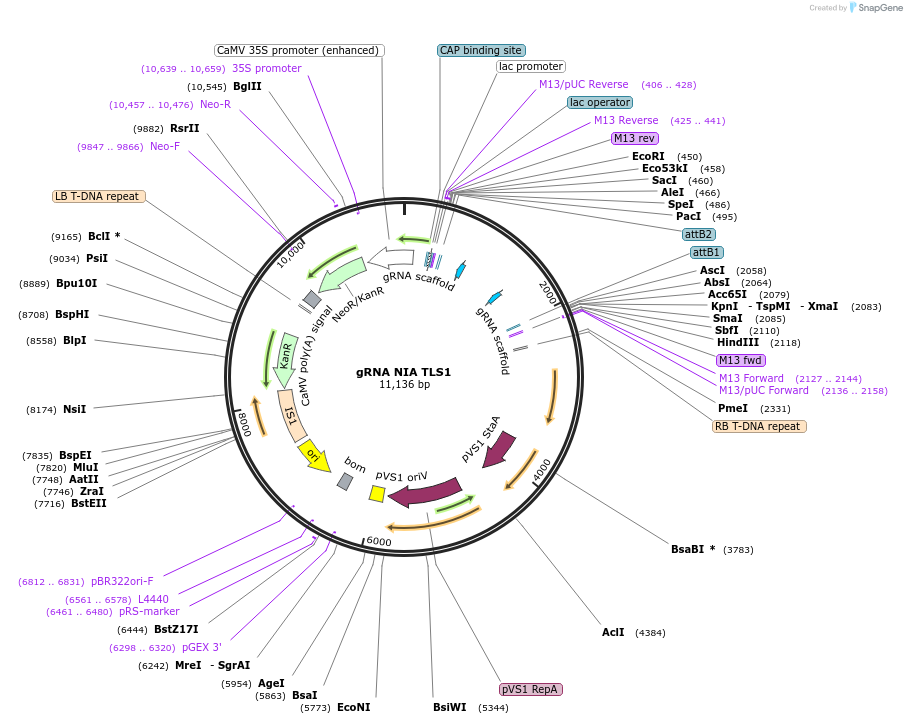gRNA NIA TLS1
(Plasmid
#196980)
-
PurposeExpresses two gRNAs targeting Arabidopsis NIA1 gene for knockout. Each gRNA is fused to TLS1 mobility signal that confers graft mobility.
-
Depositing Lab
-
Sequence Information
Ordering
| Item | Catalog # | Description | Quantity | Price (USD) | |
|---|---|---|---|---|---|
| Plasmid | 196980 | Standard format: Plasmid sent in bacteria as agar stab | 1 | $89 | |
Backbone
-
Vector backbonepMDC100
- Total vector size (bp) 11136
-
Vector typePlant Expression
-
Selectable markersKanamycin
Growth in Bacteria
-
Bacterial Resistance(s)Kanamycin, 50 μg/mL
-
Growth Temperature37°C
-
Growth Strain(s)DH5alpha
-
Copy numberHigh Copy
Gene/Insert
-
Gene/Insert nameAtNIA1 gRNAs fused to TLS1 tags
-
gRNA/shRNA sequenceACAACACTGCTGACTCTGCA, GATGGGTTACAACGTGAAGG
-
SpeciesA. thaliana (mustard weed); Streptococcus pyogenes
- Promoter pU6-26, pU6-29
Cloning Information
- Cloning method Restriction Enzyme
- 5′ cloning site BsaI (destroyed during cloning)
- 3′ cloning site BsaI (destroyed during cloning)
- 5′ sequencing primer CCAATTCAGTCGACTGGATCC
- 3′ sequencing primer ggcggccgctctagaactag
- (Common Sequencing Primers)
Resource Information
-
Supplemental Documents
Terms and Licenses
-
Academic/Nonprofit Terms
-
Industry Terms
- Not Available to Industry
Trademarks:
- Zeocin® is an InvivoGen trademark.
Depositor Comments
Please refer to the GO CRISP Cloning Protocol linked above for additional information.
These plasmids were created by your colleagues. Please acknowledge the Principal Investigator, cite the article in which the plasmids were described, and include Addgene in the Materials and Methods of your future publications.
-
For your Materials & Methods section:
gRNA NIA TLS1 was a gift from Friedrich Kragler (Addgene plasmid # 196980 ; http://n2t.net/addgene:196980 ; RRID:Addgene_196980) -
For your References section:
Heritable transgene-free genome editing in plants by grafting of wild-type shoots to transgenic donor rootstocks. Yang L, Machin F, Wang S, Saplaoura E, Kragler F. Nat Biotechnol. 2023 Jan 2. doi: 10.1038/s41587-022-01585-8. 10.1038/s41587-022-01585-8 PubMed 36593415







